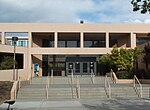University of New Mexico Hospital

The University of New Mexico Hospital (locally known as either University Hospital, UNM Hospital, or shortened to UNMH) is a public teaching hospital located in Albuquerque, New Mexico, immediately north of the main campus of the University of New Mexico. The hospital is the only Level I trauma center in the state of New Mexico, and also houses the only certified burn unit and designated stroke center in the state. In addition, UNMH also contains the only children's hospital in New Mexico, and is the state's sole source of 13 pediatric sub-specialties. As a safety net hospital, UNMH serves a large percentage of the uninsured and under-insured population of the state. The hospital is the main teaching facility for the University of New Mexico School of Medicine.
Excerpt from the Wikipedia article University of New Mexico Hospital (License: CC BY-SA 3.0, Authors, Images).University of New Mexico Hospital
Lomas Boulevard Northeast, Albuquerque Nob Hill
Geographical coordinates (GPS) Address Phone number Website Nearby Places Show on map
Geographical coordinates (GPS)
| Latitude | Longitude |
|---|---|
| N 35.088 ° | E -106.618 ° |
Address
University Hospital
Lomas Boulevard Northeast 2211
87131 Albuquerque, Nob Hill
New Mexico, United States
Open on Google Maps






